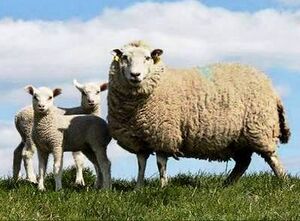Vadehavslam (Wadden Sea lamb)

BGB Vadehavslam ‘Vadehavslam’ is Danish lamb born and reared in the specified geographical area. The sheep are of the Texel breed or crosses of Texel with other breeds (other breeds: sometimes, when a ewe has its first lamb, the Texel breed is paired with rams of the Suffolk or Gotland pelt sheep breeds) that have traditionally been used on the salt meadows. The aim of breeding efforts over the years has been to produce a sheep which is not only suited to its habitat, but which also produces large, meaty lambs. This, together with the grass on which the lambs graze in the salt meadows, sets these lambs apart from lamb produced in other parts of the country.
Quality requirements of lamb:
The time of slaughter (age of the lamb when slaughtered) depends on its weight, which must be between 19 kg and 25 kg. In addition, the undertaking responsible for the slaughter must visually identify the fat content in the slaughterhouse. (A notification was previously used for lambs, similar to the one used by Danish Crown for bovine animals. The notification is no longer used for lambs, which is why the undertaking responsible for slaughter has to visually identify the fat content in the slaughterhouse).
Feed:
In winter at least 50 % of the animals’ feed must be produced in the defined area. In the winter months the lambs feed on grass, maize, silage and, in the last part of the feeding period, on hay supplemented with barley. The animals must graze in the salt meadows and the foreland of the specified geographical area for at least 4.5 months per year.
Concise definition of the geographical area:
The geographical area is the Wadden Sea region of south-west Denmark. The Wadden Sea region comprises the three islands of Romø, Mandø and Fanø, as well as the mainland, where the Danish Wadden Sea region is delimited in the south by the German border. The boundary to the north is identical to the northern boundary of the Wadden Sea National Park. The area is delimited to the east by the A11 motorway.
Specificity of the geographical area:
Ribe was founded in around 710 as a trading post, and archaeological digs have revealed the goods sold there. Some of the products found on the market at an early stage were mutton and lamb. The sheep and lambs were from the villages in the salt meadows along the Wadden Sea, meaning the local farmers were rearing sheep and lambs as early as the Iron Age.
The production of ‘Vadehavslam’ (Wadden Sea lamb) builds on this time-honoured tradition of rearing sheep and lambs in the salt meadows. Each year the area was hit by storm floods which flooded the farmland. The sea left behind fertile silt, thereby creating lush meadows in the salt marshes where the animals grazed in the summer, and where winter fodder could be gathered.
In the article Jordbundsundersøgelser i marsken (Soil Surveys in the Salt Meadows) from the Tidsskrift for planteavl (Plant Breeding Journal) of 1968, Lorens Hansen looks at soil samples taken only from the salt meadows. The article states that the soil of the salt meadows is naturally very rich in potassium, which corresponds to the high clay content and means of formation. In normal arable land the sodium content is seldom determined because it is very low, with no impact on the soil structure. A very high sodium content is often found in the soil of the salt meadows due to the sea salt deposited when the meadows were created.
The hardy grasses that thrive in the salt meadows are rich and not particularly well suited to conventional agriculture, but are almost ideal for grazing. The hardy grasses which thrive in the salt meadows are rich in nutrients but also able to withstand different types of weather. In fact it is the harsh, salty impact of the Wadden Sea that makes the grazing in the area unique. The following plants and grasses are found in particular on the foreland:
— fine grass, small self-sown white clover, bird’s-foot trefoil, yellow rattle, buttercups and thrift flourish furthest in towards the dykes
— sea lavender, sea arrowgrass and some rough grass grow in the lower-lying area
— sea meadow grass and glasswort grow in the furthest/lowest part of the foreland
Specificity of the product:
The lambs are bred to be able to live in the harsh surroundings of the salt meadows and on the foreland. Breeding has also resulted in larger, more meaty lambs with a lean meat structure. ‘Vadehavslam’ has a distinctive salty taste.
Causal link between the geographical area and a specific quality, the reputation or other characteristic of the product:
The harsh surroundings and the special farming conditions are very demanding of the farmers that produce lamb in the Wadden Sea region. Local farmers draw on their knowledge and experience to produce strong, hardy lambs in the conditions created by nature along the Wadden Sea.
The lambs are large and meaty; their meat has a distinctive salty taste due to the special conditions for growth in the area. When the land is flooded with seawater, salt and minerals are deposited in the soil.
The lambs graze on the salty meadows, where the high potassium and sodium content in the grasses affects the taste of the lamb’s meat, giving the ‘Vadehavslam’ its special quality and distinct salty taste.
‘Vadehavslam’ has for many years been a well-known product throughout Denmark and the production of ‘Vadehavslam’ is described in tourist brochures on the Wadden Sea region, the Wadden Sea National Park being an important characteristic of the area.
Reference: The European Commission